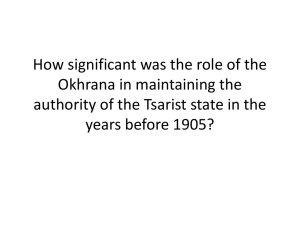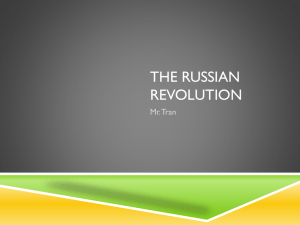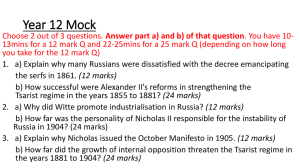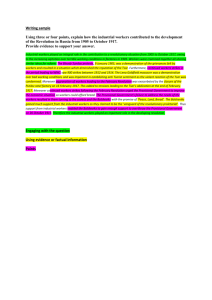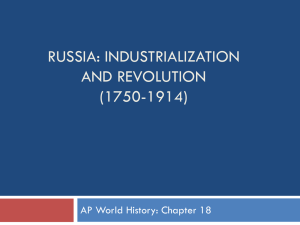Activity S – The nature extent and significance of the 1905 revolution
advertisement
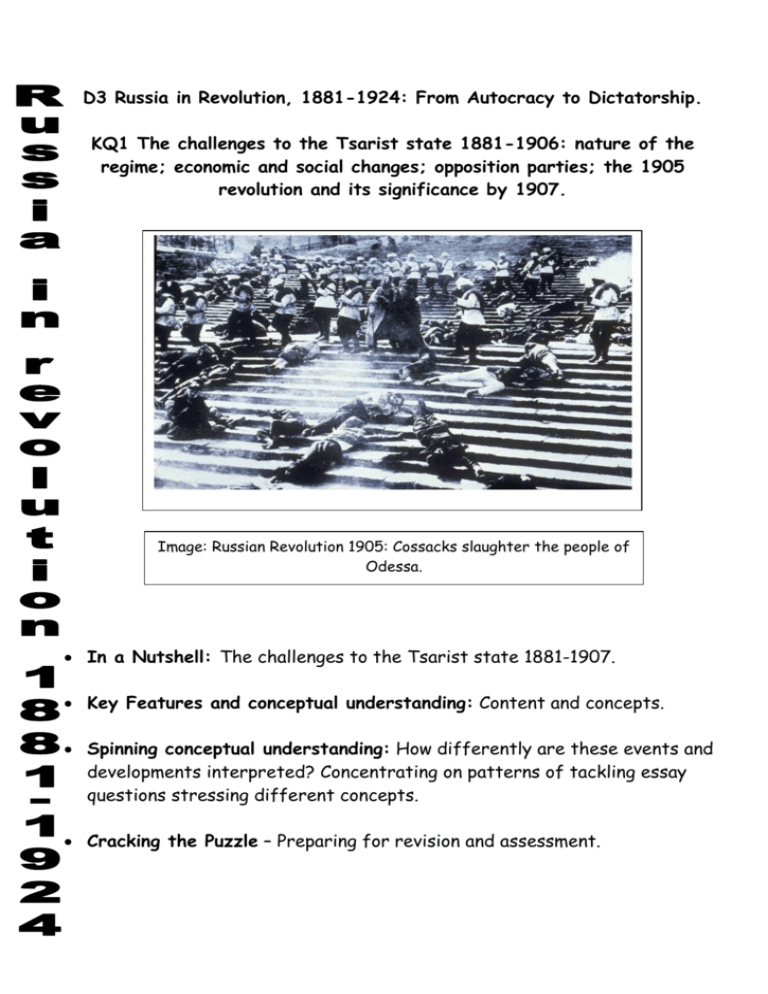
D3 Russia in Revolution, 1881-1924: From Autocracy to Dictatorship. KQ1 The challenges to the Tsarist state 1881-1906: nature of the regime; economic and social changes; opposition parties; the 1905 revolution and its significance by 1907. Image: Russian Revolution 1905: Cossacks slaughter the people of Odessa. In a Nutshell: The challenges to the Tsarist state 1881-1907. Key Features and conceptual understanding: Content and concepts. Spinning conceptual understanding: How differently are these events and developments interpreted? Concentrating on patterns of tackling essay questions stressing different concepts. Cracking the Puzzle – Preparing for revision and assessment. (I)In a Nutshell: The challenges to the Tsarist state 18811907. The key features and concepts The reign of Alexander III and first half of Nicholas II from 1881-1907. Students should understand the nature of the autocracy, the assassination of Alexander II and the use of repression and anti-reformist stance. Students should be aware of urbanisation and industrialisation transforming the Russian empire and the growth of reformist and revolutionary groups such as the Kadets, Social Revolutionaires and the Social Democrats. Students should understand the causes of the 1905 revolution, including the impact of the Russo-Japanese War, and the nature, extent and significance of that revolution. Activity 1 : Introductory hook to Key features and concepts Think about the collection of visual evidence that you have been asked to consider. Think about the following features: Geography, politics, economy, society and culture. What can we infer from these images about Tsarist Russia in the late 19th Century? Activity 2 – On your marks…engaging conceptually with the key features through timeline. The timeline makes many brief references to the events of the period 1881-1907. Use the timeline to colour code according to the extent of challenge to the Tsarist state and plot your living graph according to the extent of this challenge.. Green Yellow Lack of challenge/effective repression. Emerging opposition but weak challenge or slight concessions made by Tsarist state. Open opposition and protest. Military opposition to threaten the future of the Tsarist state. Orange Red Extent of challenge to Tsarist state 100% 50% Series 1 0% 1880 1890 1900 1910 The Late nineteenth Century 1881: Tsar Alexander II is killed by members of Narodnaya volya; the new tsar, Alexander III, begins a repressive, racist and xenophobic crackdown on the Russian people. • 1883: The first Russian Marxist group is formed (in Switzerland): The Group for the Liberty of Labour. • 1880-1900: Russia begins a period of swift industrialisation under Witte, creating a densely packed factory workforce living in poor conditions and doing dangerous jobs; this new population looks remarkably like Marx's proletariat and Russian Marxism grows around them. The new workers are politically aware, organising and striking. • 1894: Death of Alexander III; Nicholas II succeeds as Tsar. • 1897: A young radical is given a three year exile in Siberia for illegal workers activities; his name is Lenin. • 1898: The First Congress of the Russian Socialist Democratic Labour Party (RSDRP) meets, an attempt to unite the many small Russian socialist/marxist groups. It takes place outside Russia and isn't very successful. The Early Twentieh Century • 1900: Socialist Revolutionary (SR) parties form, reflecting the aims of the Narodniki and the methods of the Narodnaya volya; Lenin is amongst a group that publishes Iskra (The Spark). • 1901-5: An economic downturn creates discontent; the zemstvos begin to organise and form a coherent agenda; workers develop a strong strikers movement. • 1902 - 7: The 'Years of the Red Cockerel', a period of rural unrest caused by anger at the injustices of the 1861 emancipation. • 1902: The campaign for a national zemstov assembly begins; Lenin publishes What is to be Done?, a work with very strong views on party organisation. • 1903: The Second RSDRP Congress meets abroad; this achieves little, but Lenin and a friend argue over organisation, creating a divide that forms two new sub groups: the Bolsheviks and Mensheviks. • 1904: The Russo-Japanese war begins. • 1904: 13 zemstovs organise a medical brigade for the war led by Prince Lvov, who persuades the Tsar to allow it; this is the first time zemstovs are allowed to unite nationally; Lvov becomes a hero. • July 1904: Plehve, Minister of Interior and hardliner against reform, killed by SR's; public either indifferent or celebratory. Other opposition groups join campaign for national zemstov assembly. • November 6-9 1904: The Zemstov Assembly: 103 representatives meeting with permission from the Minister of Interior; produces resolution on assembly and reforms, which is rejected by the Tsar. • December 12 1904: Decrees expand the rights of zemstovs and ease censorship, but there is no assembly. 1905 • January 3-8: 120,000 workers strike in St. Petersburg; government warns against any organised marches. • January 9: Bloody Sunday. 150,000 striking workers and their families march through St. Petersburg to deliver a protest to the Tsar, but are shot and ridden down on multiple occasions by the army. • January: Reaction to the massacre spreads across neighbouring regions, especially the industrial centers which experience spontaneous workers' strikes. • February: The strike movement spreads down to the Caucasus. • February 4: Grand-Duke Sergei Alexandrovich is killed by an SR assassin as protests grow. • February 6: Notably large rural disorder, especially in Kursk. • February 18: Reacting to the growing troubles, Nicholas II orders the creation of a consultative assembly to report on constitutional reform; the move is less than the revolutionaries want, but it gives them impetus. • March: The strike movement and unrest reaches Siberia and the Urals. • April 2: The second National Congress of Zemstovs again demands a constitutional assembly; the Union of Unions formed. • May: Embarrassment for the government as the Baltic Fleet is easily sunk, having spent 7 months sailing round to Japan. • June: Soldiers used against strikers in Lodz. • June 18: Odessa is halted by a large strike. • June 14-24: Sailors mutiny on the Battleship Potemkin. • August: Moscow holds the first Conference of the Peasants union; Nizhnii holds the First Congress of the Muslim Union, one of many groups pushing for regional - often national - autonomy. • August 6: Tsar issues a manifesto on the creation of a state Duma; this plan, created by Bulygin and nicknamed the Bulygin Duma, is rejected by revolutionaries for being too weak and having a tiny electorate. • August 23: Treaty of Portsmouth ends the Russo-Japanese war; Russia has been beaten by an opponent they were expected to easily defeat. • September 23: Printers strike in Moscow, the start of Russia's first General Strike. • October 1905 - July 1906: The Peasant Union of the Volokolamsk District creates the independent Markovo Republic; it survives, 80 miles from Moscow, until the government crushes it in July 1906. • October 6: Rail workers join the strike. • October 9: As telegraph workers join the strike, Witte warns the Tsar that to save Russia he must make great reforms or impose a dictatorship. • October 12: Strike action has developed into a General Strike. • October 13: A council is formed to represent striking workers: the St. Petersburg Soviet of Workers Deputies; it functions as an alternative government. The Mensheviks dominate it as the Bolsheviks boycott and similar soviets are soon created in other cities. • October 17: Nicholas II issues the October Manifesto, a liberal scheme proposed by Witte. It grants civil liberties, the need for Duma consent before passing laws and a widening of the Duma electorate to include all Russians; mass celebrations follow; political parties form and rebels return, but acceptance of the Manifesto pushes the liberals and socialists apart. The St. Petersburg soviet prints its first issue of the newsheet Izvestia; left and right groups clash in streetfights. • October: Lvov joins the Constitutional Democrat (Kadet) party, which includes the more radical zemstov men, nobles and scholars; conservative liberals form the Octobrist Party. These are the people who have led the revolution so far. • October 18: N. E. Bauman, a Bolshevik activist, is killed during a streetfight triggering a street war between the Tsar supporting right and the revolutionary left. • October 19: The Council of Ministers is created, a government cabinet under Witte; leading Kadets are offered posts, but refuse. • October 20: Bauman's funeral is the focus of major demonstrations and violence. • October 21: The General Strike is ended by the St. Petersburg Soviet. • October 26-27: The Kronstadt mutiny. • October 30-31: The Vladivostok Mutiny. • November 6-12: The Peasants Union holds a conference in Moscow, demanding a constituent assembly, land redistribution and political union between peasants and urban workers. • November 8: The Union of Russian People is created by Dubrovin. This early fascist group aims to fight against the left and is funded by government officials. • November 14: The Moscow branch of the Peasants Union is arrested by the government. • November 16: Telephone/graph workers strike. • November 24: Tsar introduces 'Provisional Rules', which at once abolish some aspects of censorship, but introduce harsher penalties for those praising 'criminal acts'. • November 26: Head of the St. Petersburg Soviet, Khrustalev-Nosar, arrested. • November 27: The St. Petersburg Soviet appeals to the armed forces and elects a triumvirate to replace Nosar; it includes Trotsky. • December 3: The St. Petersburg Soviet is arrested en masse after Socialist Democrats (SD) hand out weapons. • December 10-15: The Moscow Uprising, where rebels and militias try to take the city through armed struggle; it fails. No other major rebellions take place, but the Tsar and the right react: the police regime returns and the army sweeps across Russia crushing dissent. • December 11: Russia's urban population and workers are enfranchised by electoral changes. • December: Nicholas II and his son given honorary membership of the Union of the Russian People; they accept. (II) Key features and conceptual understanding: Depth studies illustrating the nature of the challenges to the Tsarist state 1881-1907 What do we need to focus on? There are many developments which, as case studies, help to reveal changes in events in Russia 1881-1905. Students should understand The nature of the autocracy. 1 Hour The assassination of Alexander II and the use of repression and anti-reformist stance. 1 Hour Urbanisation and industrialisation transforming the Russian Empire. 1 Hour The growth of reformist/revolutionary groups such as the Kadets, Social Revolutionaries and the Social Democrats. 1 Hour The causes of the 1905 revolution, including the impact of the Russo-Japanese War. 1 Hour The nature, extent and significance of the 1905 revolution by 1907. 1 Hour Memory Retrieval strategies A Autocracy AR Assassination and Repression UI Urbanisation and Industrialisation RR Reform and Revolutionary groups 1905 1905 S Significance Activity A – The nature of the autocracy! Using Michael Lynch “Reaction and Revolutions: Russia 1881-1924” 2nd edition p3-13, summarise the key features concerning the nature of Russia’s Tsarist autocracy. Key features of Imperial Russia 1 Geography and Geography People Description and Explanation of Key features. Geography Empire Politics 2 Tsarist Government Tsar The Imperial Council The Cabinet of Ministers The Senate 3 Russian Orthodox Church 1 2 3 4 4 Army 1 2 3 4 1 2 3 4 1 2 3 4 1 2 3 4 1 2 3 4 Institutions 5 Bureaucracy 6 Social classes Society 7 Industry Economy 8 Agriculture and peasantry Design a mind map which answers the question “Why was reform so difficult in Tsarist Russia?” Consider the points you would raise under the following categories; Geographical, political, institutional, economic, social and cultural. Activity AR – Analysis of the consequences of the assassination of Alexander II and the use of repression and anti-reformist stance! The reign of Alexander III 1881-1894 started prematurely after his father was blown to pieces by a terrorist bomb planted by “The Peoples Will” a group of disaffected members of the intelligentsia. Alexander III responded by executing five of the assassins and introducing a series of repressive measures that became known as “the Reaction”. Using Michael Lynch “Reaction and Revolutions: Russia 1881-1924” 2nd edition p16-18, summarise the key Measures of Alexander III’s repressive measures and consider their success. Alexander III’s policies Key Measures Description, Explanation and Analysis 1 Statute of State Security 1881 Success? The Reaction 2 The University Statute Success? 3 The Zemstva Act Success? Terms of Russification Success? Russification Effects of Russification Success? Analysis of Russification Success? The role of Pobedonostev Pobedonostev Success? Activity UI – Analysis of the extent of Urbanisation and Industrialisation in transforming the Russian Empire! The reign of Alexander III coincided with a period of remarkable economic growth, in which Tsarism showed its unwillingness to evolve with the economic and social transformation of Russia. Using Michael Lynch “Reaction and Revolutions: Russia 1881-1924” 2nd edition p18-23, summarise the key economic changes 18811907. Economic change The role of Sergei Witte, Minister of Finance 18931903. Analysis of extent of transformation Militaristic motives of the government Witte’s aims Witte’s policies for generating capital for industrial investment Growth of the railways and its impact Growth of industry Coal Pig Iron Oil Grain Growth of population Witte’s critics and resulting economic problems by 1903 Design a mind map which answers the questions “What were the causes of Industrialisation and how successful was it?” Consider the points you would raise under the following categories; Causes-Population, Government, Military, Private enterprise, Witte and transport. Analysis Evidence of success and limitations Activity RR – Analysis of extent of threat posed by the growth of reformist and revolutionary groups! Using Michael Lynch “Reaction and Revolutions: Russia 1881-1924” 2nd edition p36-45, summarise the nature and evolution of opposition groups to Russia’s Tsarist autocracy and consider their effectiveness. Opposition groups to 1907 Factions of groups Description, Explanation and Analysis of extent of threat The Populists Threat? The Social Revolutionaries Threat? The Social Democrats Mensheviks Threat? Bolsheviks Threat? The Liberals Octoberists Threat? The Constitutional Democrats (Kadets) Threat? Activity 1905 – Analysis of the causes of the 1905 revolution, including the impact of the Russo Japanese War! Using Michael Lynch “Reaction and Revolutions: Russia 1881-1924” 3rd edition p31-39, summarise the causes of the 1905 Revolution. Causes of the 1905 Revolution Military The course of the Russo Japanese war p31-2 Analysis of relative significance RS? Mutinies in the army and navy p36-7 RS? Political problems The consequences of political repression since 1881. P11-13, p36 RS? The incompetence of Tsarist government in dealing with the crises of 1905. Bloody Sunday p34 RS? The reaction to Bloody Sunday p34 RS? Economic and social problems Economic recession and industrial unrest P34 RS? Peasant fears p34-5 RS? The non-Russian national minorities p36 Activities of SR’s p34 Reformist Kadets p36 and SD’d p38-9 revolutionary RS? RS? Activity S – The nature extent and significance of the 1905 revolution by 1907! Using Michael Lynch “Reaction and Revolutions: Russia 1881-1924” 2nd edition p49-50 summarise the nature and consequences of the 1905 Revolution. The significance of the Analysis of extent of change brought about by the 1905 1905 Revolution revolution. Weakness of leadership shown by the opposition groups. P49 Tsarism emerged stronger rather than weaker. P49 Government concessions (October manifesto and Peasant mortgages) p49. Divisions amongst the opposition groups. P49 Design a mind map which consider the extent to which there was a revolution in Russia between 1905-1907. Consider the evidence for and against under the categories Political, economic, social and cultural. (III) Spinning Conceptual understanding: How differently are these events and developments interpreted? Activity 9 Mind mapping of the key features and conceptual understanding Consider the different possible types of question that the examiners could design on this period given the following question types. You will be asked to mind map some of these responses. i) Analyse key features essay pattern How extensive was opposition to...? How far is it accurate to describe.....as....? ii) Analyse causation essay pattern Why did...? How far was...in increasing opposition/support...? How far was...the main case of...? How far do you agree that...because of...? iii) Analyse consequence/effects essay pattern How far was...a success? How far is it accurate to say achieved/achieved little for....? iv) Analyse change/continuity essay pattern How far did...improve...? How far did....change in the years...? v) Analyse significance essay pattern How important was...in contributing to the development of...? How important was....in the outcome of...? How important was....in the beginning of...? Cracking the Puzzle- Preparing for Revision and Assessment Activity 10 : Complete Trigger Memory Activity 1881-1906 using your background notes. An explanation on how to complete this is in your guidance booklet. Activity 11 : There are many excellent Russian Revolution websites which can be used to revisit the material covered so far. You should download some of these resources to supplement your main areas of note taking in this period. These include www. en.wikipedia.org/wiki/Russian_Revolution_of_1905 www. www.thecorner.org/hist/russia/revo1905.htm www. www.spartacus.schoolnet.co.uk/RUS1905.htm www. www.historystudystop.co.uk/php/displayarticle.php?article=72&topic=meu www. www.fordham.edu/halsall/mod/modsbook39.html www. creeca.wisc.edu/petrovich/418A.html Activity 12: Consolidating your knowledge of developments 1881-1906 through playing games Your teacher will load one of three multiple choice games for your class to play. Enjoy demonstrating your knowledge to answer the quiz questions on either Penalties, Fling or MC generator. Activity 13 : Revisit the examination criteria and advice on tackling the examination questions given in the guidance booklet. Apply these techniques to the specimen examination. You may be asked to work individually, in pairs or in groups. Specimen questions from this syllabus D3 – Russia in Revolution, 1881–1924: From Autocracy to Dictatorship EITHER 5. How far was the Russo Japanese War the main cause of the 1905 Revolution? (Total 30 marks) OR 6. How far do you agree that the Romanovs survived the 1905 Revolution because of the weakness of the opposition? (Total 30 marks) Analysis of key features 1 Extent...a lot Accurate....very Possibilities key features include Political Analysis of key features 2 Extent....very little Accurate...not very Possibilities key features include Analysing Key features essay planning. How extensive was opposition to...? How far is it accurate to describe.....as....? Political Conclusion. Relative significance and Links Economic Economic Social Social Cultural Cultural Cause 1 Background conditions (PESRC) Cause 2 Triggering factors (PESRC) Cause 3 Immediate circumstances (PESRC) Analysing causation essay planning. Why did...? How far was...in increasing opposition/support...? How far was...the main case of...? How far do you agree that...because of...? Conclusion. Relative significance of causes and Links Analysis of consequences/effects 1 Extent...a lot Accurate....very Possibilities include Political Analysis of consequences/effects 2 Extent...little Accurate....not very Analysing consequences/effects essay planning. How far was...a success? How far is it accurate to say achieved/achieved little for....? Possibilities include Political Conclusion. Relative significance and Links Economic Economic Social Social Cultural Cultural Analysis of change/continuity 1 Change...a lot Improve....a lot Continuity...a lot Possibilities changes/continuities include Political Analysis of change/continuity 2 Change...not much Improve....not much Continuity...not much Analysing change/continuity essay planning. How far did...improve...? How far did....change in the years...? Possibilities changes/continuities include Political Conclusion. Extent of change/continuity Economic Social Cultural Economic Social Cultural Analysis of significance 1 Important...very significant Possible significance include Political Economic Analysis of significance 2 Important...not very significant Analysing significance essay planning. How important was...in contributing to the development of...? How important was....in the outcome of...? How important was....in the beginning of...? Conclusion. Relative significance and Links Possible significance include Political Economic Social Social Cultural Cultural Unit 1: Generic Level Descriptors Target: AO1a and AO1b (13%) (30 marks) Essay - to present historical explanations and reach a judgement. Level Mark Descriptor Level 1 1-6 Candidates will produce mostly simple statements. These will be supported by limited factual material which has some accuracy and relevance, although not directed at the focus of the question. The material will be mostly generalised. There will be few, if any, links between the simple statements. The writing may have limited coherence and will be generally comprehensible, but passages will lack both clarity and organisation. The skills needed to produce effective writing will not normally be present. Frequent syntactical and/or spelling errors are likely to be present. Low Level 1: 1-2 marks The qualities of Level 1 are displayed, but material is less convincing in its range/depth and the quality of written communication does not conform. Mid Level 1: 3-4 marks The qualities of Level 1 are displayed, but material is less convincing in its range/depth or the quality of written communication does not conform. High Level 1: 5-6 marks The qualities of Level 1 are securely displayed. Level 2 7-12 Candidates will produce a series of simple statements supported by some mostly accurate and relevant factual material. The analytical focus will be mostly implicit and there are likely to be only limited links between the simple statements. Material is unlikely to be developed very far. The writing will have some coherence and will be generally comprehensible, but passages will lack both clarity and organisation. Some of the skills needed to produce effective writing will be present. Frequent syntactical and/or spelling errors are likely to be present. Low Level 2: 7-8 marks The qualities of Level 2 are displayed, but material is less convincing in its range/depth and the quality of written communication does not conform. Mid Level 2: 9-10 marks The qualities of Level 2 are displayed, but material is less convincing in its range/depth or the quality of written communication does not conform. High Level 2: 11-12 marks The qualities of Level 2 are securely displayed. Level 3 13-18 Candidates' answers will be attempt analysis and will show some understanding of the focus of the question. They will, however, include material which is either descriptive, and thus only implicitly relevant to the question's focus, or which strays from that focus. Factual material will be accurate but it may lack depth and/or relevance in places. The writing will be coherent in places but there are likely to be passages which lack clarity and/or proper organisation. Only some of the skills needed to produce convincing extended writing are likely to be present. Syntactical and/or spelling errors are likely to be present. Low Level 3: 13-14 marks The qualities of Level 3 are displayed, but material is less convincing in its range/depth and the quality of written communication does not conform. Mid Level 3: 15-16 marks The qualities of Level 3 are displayed, but material is less convincing in its range/depth or the quality of written communication does not conform. High Level 3: 17-18 marks The qualities of Level 3 are securely displayed. 20 Level 4 19-24 Candidates offer an analytical response which relates well to the focus of the question and which shows some understanding of the key issues contained in it. The analysis will be supported by accurate factual material which will be mostly relevant to the question asked. The selection of material may lack balance in places. The answer will show some degree of direction and control but these attributes may not be sustained throughout the answer. The candidate will demonstrate the skills needed to produce convincing extended writing but there may be passages which lack clarity or coherence. The answer is likely to include some syntactical and/or spelling errors. Low Level 4: 19-20 marks The qualities of Level 4 are displayed, but material is less convincing in its range/depth and the quality of written communication does not conform. Mid Level 4: 21-22 marks The qualities of Level 4 are displayed, but material is less convincing in its range/depth or the quality of written communication does not conform. High Level 4: 23-24 marks The qualities of Level 4 are securely displayed. Level 5 25-30 Candidates offer an analytical response which directly addresses the focus of the question and which demonstrates explicit understanding of the key issues contained in it. It will be broadly balanced in its treatment of these key issues. The analysis will be supported by accurate, relevant and appropriately selected factual material which demonstrates some range and depth. The exposition will be controlled and the deployment logical. Some syntactical and/or spelling errors may be found but the writing will be coherent overall. The skills required to produce convincing extended writing will be in place. Low Level 5: 25-26 marks The qualities of Level 5 are displayed, but material is less convincing in its range/depth and the quality of written communication does not conform. Mid Level 5: 27-28 marks The qualities of Level 5 are displayed, but material is less convincing in its range/depth or the quality of written communication does not conform. High Level 5: 29-30 marks The qualities of Level 5 are securely displayed. NB: The generic level descriptors may be subject to amendment in the light of operational experience. Note on Descriptors Relating to Communication Each level descriptor above concludes with a statement about written communication. These descriptors should be considered as indicative, rather than definitional, of a given level. Thus, most candidates whose historical understanding related to a given question suggests that they should sit in a particular level will express that understanding in ways which broadly conform to the communication descriptor appropriate to that level. However, there will be cases in which high-order thinking is expressed relatively poorly. It follows that the historical thinking should determine the level. Indicators of written communication are best considered normatively and may be used to help decide a specific mark to be awarded within a level. Quality of written communication which fails to conform to the descriptor for the level will depress the award of marks by a sub-band within the level. Similarly, though not commonly, generalised and unfocused answers may be expressed with cogency and even elegance. In that case, quality of written communication will raise the mark by a sub-band. Unit 1 Assessment Grid Question Number AO1a and b Marks Total marks for question Q (a) or (b) 30 30 Q (a) or (b) 30 30 Total Marks 60 60 % Weighting 25% 25% 21 22

